Cultivating Peach Trees from Seed: A Detailed Guide
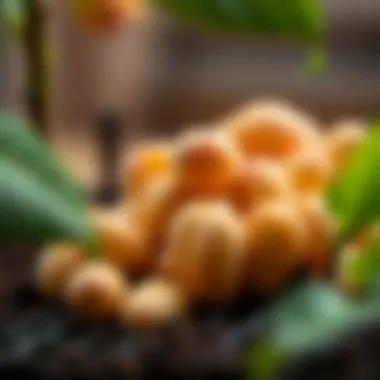
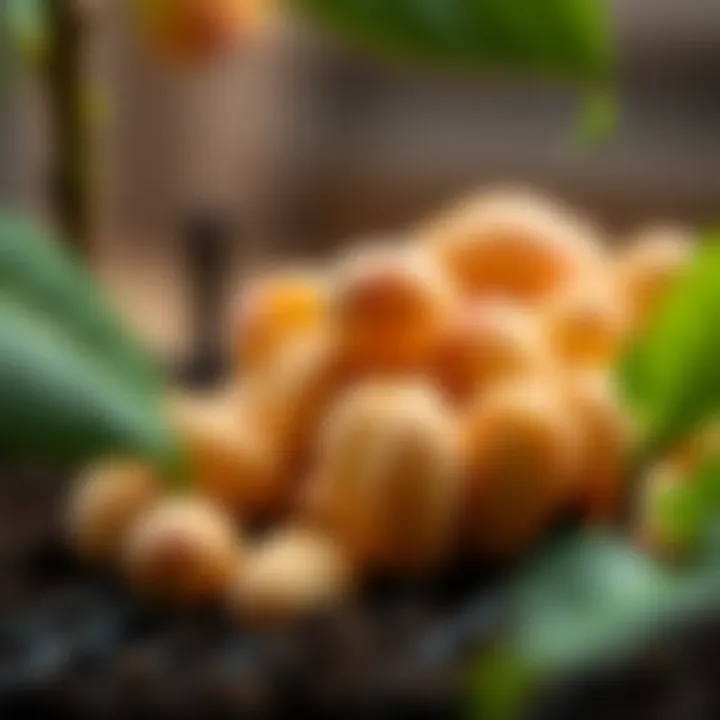
Intro
Growing peach trees from seed is not just a delightful hobby; it’s a journey filled with anticipation and reward. Peach trees, scientifically Prunus persica, are renowned for their luscious fruits and vibrant blossoms. This guide aims to illuminate the path from seed to tree, drawing both newbies and seasoned gardeners into the world of peach cultivation.
What most novice cultivators might not realize is that successfully growing peach trees from seeds requires more than just tossing a peach pit into the ground. It’s a meticulous process that demands an understanding of various stages – from seed selection to ongoing care – all while considering environmental factors.
As you embark on this agricultural venture, patience becomes your best ally. During this guide, we’ll explore not only the technicalities but also the little secrets that can make or break your peach-growing journey. Let’s get down to brass tacks and uncover the art and science behind nurturing your very own peach trees.
Understanding Peach Varieties
When embarking on the journey of growing peach trees from seed, a solid understanding of peach varieties can be critical for success. Different varieties can influence not only the flavor and quality of fruit produced, but also their adaptability to local conditions and your personal growing experience. Selecting the right variety is essential, as it sets the stage for everything that follows, from germination to harvest.
In this section, we will break down various types of peaches to aid in making informed choices. We will also explore how climate and environmental factors can influence which varieties will thrive in your garden.
Types of Peaches
Clingstone vs. Freestone
The distinction between clingstone and freestone peaches might seem minor, but it is significant when it comes to the uses and enjoyment of these fruit. Clingstone peaches have flesh that clings to the pit, making them a bit trickier to process and enjoy fresh. This type is often preferred for canning and preserving because they tend to hold their texture well. Freestone peaches, on the other hand, separate easily from the pit, making them a popular choice for fresh eating, desserts, and salads. The ease of removal can be a game changer, especially when preparing meals or feeding a crowd.
Benefits of choosing freestone varieties include their versatility in culinary applications, while clingstones might offer richer flavor profiles ideal for processing. For those who value convenience in the kitchen, freestone peaches are a clear winner; yet clingstone peaches can provide superior taste for those willing to navigate their preparation challenges.
Color Varieties
The color of peaches can range from pale yellow to deep crimson, and this variety does more than just catch one’s eye. The hues can indicate different flavor profiles and sugar content. Yellow peaches, for example, are classic in flavor and sweetness, while white peaches tend to be quite aromatic, offering a perfumed sweetness.
Choosing peaches based on color can impact your garden aesthetic and flavor experiences. White peaches can sometimes have a delicate taste that might not stand up well when cooked, while the robust yellow varieties are generally more versatile, whether enjoyed fresh, baked, or grilled.
One unique feature of color varieties is how they can signal ripeness and readiness to pick. A deepening color can often mean a fruit is at its peak, guiding enthusiastic gardeners in their fruit harvesting journey.
Flavor Profiles
Peach flavor profiles vary significantly, from the honey-sweet and floral notes of white peaches to the tangy, tart flavors found in some yellow varieties. This rich diversity means that, when cultivating your peach trees, the choice of variety can greatly affect your end product. Growing peaches with varying flavors can enhance fruity desserts, jams, or just give you an exciting array of tastes fresh from the tree.
Flavor variety is essential not only in satisfying personal preferences but also in creating a dynamic and diversified garden yield. Different varieties can also appeal to various audiences, from home cooks to professional chefs, eager to utilize unique flavor notes in their dishes.
Choosing the Right Variety
Climate Considerations
Climate plays a pivotal role in selecting the peach variety you’d like to cultivate. Some peach types are better suited for the warm, dry summers found in the southern USA, while others can handle cooler conditions in northern climates. When choosing your peach variety, consider the required chilling hours necessary for the tree to set fruit. Each type has its own threshold, and understanding where you live can save gardeners from disappointment.
"Selecting a peach variety that thrives in your specific climate can enhance both yield and flavor quality."
Moreover, local pests and disease pressures may also dictate which varieties will survive and flourish. Be sure to seek local advice or research which varieties have proven successful in your region.
Growing Conditions
Successful peach cultivation is directly linked to the conditions in which they’re grown. Soil type, drainage, and sunlight all play vital roles in growth. Varieties that thrive in sandy, well-drained soil might not fare as well in clay-heavy environments.
Additionally, consider the role of sunlight; peaches require at least 6 hours of direct sun each day. Varieties adapted to withstand strong sunlight or partial shade can make the difference between a bountiful harvest and an underperforming tree. Your personal growing conditions should always lead your variety selection.
Personal Preferences
Ultimately, your own taste and goals should guide your peach variety choices. Some people prefer the sweetness of a summer peach for fresh eating, while others are looking for peaches that can withstand cooking processes for pies or jams. This preference may lead you to experiment with a few different varieties.
When selecting, also think about maintenance and care. Some varieties might demand more attention in terms of pruning and pest control than others, so factor in your confidence and willingness in terms of care.
Choosing the right peach varieties from the start makes all the difference in cultivating a personal orchard that not only feeds your family but brings joy to your gardening experience. By understanding the intricacies of peach types, and harmonizing them with your local conditions and personal tastes, you can lay a strong foundation for successful peach tree planting.
Preparing to Grow Peach Trees from Seed
Growing peach trees from seed invites gardeners into a rewarding endeavor. The preparation stage is not merely a preliminary step; it sets the foundation for successful cultivation. Each detail, from the selection of seeds to their initial treatment, can significantly influence the health and productivity of the future trees.
Harvesting Seeds
Optimal Time for Harvesting
Determining the right moment to harvest peach seeds is crucial for the final outcome. Generally, seeds should be collected after the peaches have fully ripened on the tree. A ripe peach has vibrant color, a distinct aroma, and a slight give when pressed. It's like waiting for the perfect moment in a story; you want to catch it when it’s just right. Harvesting too early can lead to immature seeds that might not germinate well, while waiting too long can result in fruit rotting.
With a keen eye, you can pick peaches when they are just perfectly ripe. This attention to detail here can yield a higher rate of germination later on, making it a beneficial choice for any aspiring gardener.
Seed Extraction Techniques
Once the peaches are harvested, extracting the seeds is the next step. The most common method involves cutting the fruit open and gently removing the seed from the flesh. This process can be a bit sticky, but it's essential. The recommendation here is to avoid damaging the seed itself, as even small cracks might affect germination.
The technique of soaking the seeds in water for a few hours before extraction also helps loosen any clingy fruit residue. This approach not only enhances ease of extraction but ensures the seeds are clean and ready for the next stage. So, investing time in proper extraction methods can increase the seeds' viability.
How to Store Seeds
After extraction, the seeds need to be stored wisely. Proper storage conditions are pivotal for seed longevity. Keeping seeds in a cool, dry place is best—temperatures around 32°F to 41°F work like charm for maintaining seed health. You can sometimes use airtight containers or resealable plastic bags lined with a desiccant to absorb moisture.
Here, the unique features of good storage practices shine through: by ensuring the seeds are well-protected from humidity and varying temperatures, you can drastically improve your chances of successful germination later on.
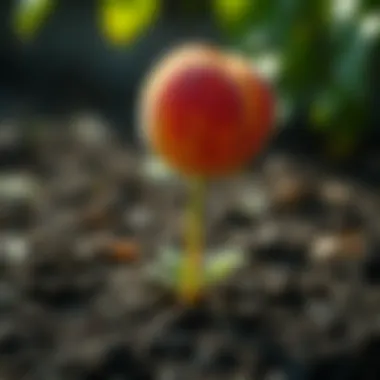
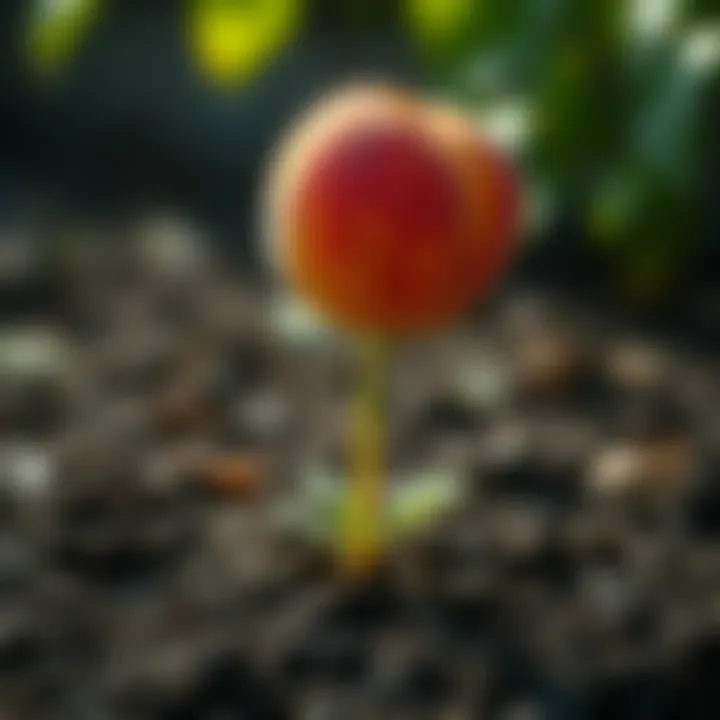
Cleaning and Drying Seeds
Removing the Fruit Residue
Cleaning seeds is another vital step that should not be overlooked. Any residual fruit can cause decay during the storage and germination processes. Rinsing the seeds under lukewarm water helps in effectively removing fruit residues. It’s a simple process that makes a world of difference.
Additionally, taking care to thoroughly clean the seeds protects them from pests and mold, which can be your worst enemies during the early growth stages. A clean seed is a happy seed, after all!
Drying Techniques
Once cleaned, seeds need to dry adequately before storage. Lay them out in a single layer on a clean, dry surface in a shady spot. Direct sunlight can be harmful, as it might overly dry the seeds and decrease their viability. Patience is key here; it might take several hours or even days to dry thoroughly.
Employing these techniques ensures that seeds enter storage in prime condition, satisfying that fundamental requirement for long-term germination success.
Preventing Mold and Decay
Mold is a sneaky foe when it comes to seed preservation. Once seeds have been cleaned and dried, storing them in a cool, dry place will help mitigate any risk. Using silica gel packets or other desiccants can further improve the environment surrounding the seeds, keeping moisture at bay.
Also, checking on stored seeds periodically can ward off unwanted surprises. This vigilance pay dividends later, as healthy seeds are more likely to sprout successfully.
In summary, proper preparation before planting peach seeds lays the groundwork for a fruitful gardening adventure. Each aspect—whether timing, technique, or storage—plays a crucial role in ensuring your gardening efforts grow into a lush, thriving fruit-bearing tree.
Germination Process
Germination is the exciting first step in the journey of transforming a seed into a thriving peach tree. This process is not just about the seed transforming, but also a critical phase where several key factors come into play, establishing a solid foundation for successful growth ahead. Without proper germination, all previous efforts become moot.
Stratification
Stratification refers to a method of treating seeds to simulate the natural conditions it needs to germinate. This step is essential for peach seeds, as they typically require a cold treatment period before sprouting. By subjecting them to specific temperature conditions, you essentially trick them into thinking they've gone through winter, which is a necessary cue for germination.
Understanding Cold Stratification
Comprehending cold stratification is crucial for anyone looking to grow peach trees from seed. It mimics the natural winter conditions peach seeds would experience in the wild. This process helps to break down the seed’s hard outer coating, allowing moisture to enter, which is essential for sprouting. Cold stratification is commonly favored by gardeners due to its simplicity and effectiveness.
One unique feature of understanding cold stratification is that it can be done using common household items. For instance, placing seeds in a damp paper towel and sealing them in a plastic bag can effectively achieve the necessary conditions.
Duration for Optimal Results
Timing is everything, especially when discussing duration for optimal results in stratification. Peach seeds should be subjected to cold treatment for about 30 to 60 days, a timeframe that maximizes your chances of successful germination. Taking the time to ensure that this duration is met is instrumental in providing the seeds with the right cues for sprouting.
A unique characteristic here is that delaying or shortening this duration can lead to poor germination rates. Seedlings may struggle, producing weak or leggy growth, making it all the more vital to adhere to this timing guideline.
Indoor vs. Outdoor Stratification
The choice between indoor and outdoor stratification can significantly impact the outcome of your seeds. Indoor stratification offers more control over temperature and humidity, which can be particularly advantageous in erratic weather conditions. With the added convenience of keeping track of time and conditions, many gardeners prefer this method.
However, outdoor stratification can engage with natural elements, such as soil moisture cycles and temperature fluctuations, which might also be beneficial. A unique aspect of outdoor stratification is that it often requires less monitoring compared to indoor methods, but it could be subject to unpredictable weather variations.
Planting Seeds
Once the seeds have undergone the necessary stratification, it’s time to plant them. This phase allows for the final step towards nurturing them into seedlings and eventually into robust trees.
Selecting Suitable Containers
Choosing the right containers for planting the seeds plays an important role in ensuring proper root development. Seed trays or pots with drainage holes are popular choices since they prevent waterlogging. A key characteristic of suitable containers is the ability to maintain sufficient moisture levels while allowing air circulation.
One unique feature of using small pots is that seedlings can then be easily transplanted when they outgrow their initial space, which is a benefit for future care.
Soil Requirements
The soil you plant the seeds in is just as crucial as the seeds themselves. A well-draining soil with a balanced pH of 6.0 to 6.8 is considered ideal for peach seedlings. Using a mix of potting soil and compost helps provide nutrients while ensuring good drainage.
A distinctive feature of these soil requirements is that they foster healthy root development by preventing diseases often associated with overly wet substrates.
Proper Seed Depth
When planting the seeds, ensuring the right depth is critical for optimal growth. A general recommendation is to plant seeds about one to two inches deep. This allows the seeds to access sufficient moisture while also protecting them from drying out and potential pests.
A unique aspect of this seed depth is that while deeper planting may seem beneficial in keeping seeds moist, overdoing it can hinder their emergence, revealing the fine line one must walk in nurturing peach seeds.
Care for Seedlings
Caring for seedlings is a vital aspect of growing peach trees from seed. If you want your young plants to thrive, put some thoughtful consideration into this stage of their development. Seedlings are particularly vulnerable to environmental changes, and their early care sets the stage for healthy growth and fruit development later on. By focusing on watering, humidity, and light requirements, you can create an ideal environment to nurture your little trees until they are strong enough to be transplanted.
Watering and Humidity
Understanding Seedling Needs
The needs of seedlings can differ significantly from mature plants. Young peach trees require a delicate balance of moisture and air; too much water can lead to root rot, while too little can dehydrate them swiftly. Monitoring the moisture content in the soil is essential. Newly sprouted seedlings generally thrive in slightly moist soil that allows for proper drainage.
An important trait of seedling needs is distinguishing between their life stages. The initial growth phase is more sensitive than the later stages. Therefore, keeping a close eye on them is benificial; you might consider using a moisture meter to avoid guesswork. Additionally, ensure the soil is rich in organic matter for better water retention without becoming boggy.
Best Watering Practices
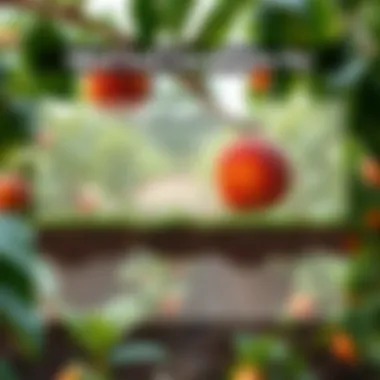

Proper watering practices are the backbone of successful seedling care. Ensuring the right frequency and amount of water can make the difference between vibrant plants and struggling ones. Watering should not be a one-size-fits-all approach; listen to what your seedlings are telling you.
Water young seedlings thoroughly, but infrequently. This encourages deeper root growth. It's prudent to use room temperature water rather than cold, as the shock of cold water can hinder growth. Furthermore, always check the topsoil – if it feels dry, go ahead and water. This practice can foster robust roots and give seedlings a fighting chance against drought and disease.
Humidity Control Methods
Humidity plays a crucial role in seedling development. Young plants typically prefer a humid environment, as they are more susceptible to desiccation due to their small leaf surface area. A humidity level between 40% to 60% is usually favorable for peach seedlings.
To maintain adequate humidity, you might want to use a humidity dome or simply cover the seedlings with plastic wrap, but don't seal it too tight. This method traps moisture and creates a mini-greenhouse effect. However, remember to ventilate periodically to avoid mold growth. Another approach is to place a shallow tray of water near the plants; as the water evaporates, it adds moisture to the air around the seedlings.
Light Requirements
Natural Light vs. Grow Lights
Light is essential for photosynthesis, and seedlings need the right amount of it to flourish. While natural sunlight can be sufficient for some gardeners, others find supplementing with grow lights an effective strategy, particularly in less than ideal conditions.
Natural light has the advantage of providing a full spectrum without extra cost. Just ensure your seedlings are positioned to receive ample sunlight throughout the day. On the flip side, grow lights offer flexibility and the ability to control light exposure, which is especially handy in regions with shorter growing seasons. However, they can require constant monitoring to avoid overheating or causing stress to the plants.
Duration of Light Exposure
The duration of light exposure is also necessary for nurturing healthy seedlings. Young peach trees generally need about 12 to 16 hours of light daily to support optimal growth. Too little light can cause seedlings to stretch and become leggy, a sign they are searching for light. Conversely, excessive light without proper rest can scorch their delicate leaves.
It's useful to establish a routine. Setting timers can help keep a consistent schedule, allowing the plants to bask under light while ensuring they also get a proper rest period. This deliberate approach minimizes stress on your seedlings, helping them develop strong and sturdy.
Identifying Light Deficiency
Recognizing signs of light deficiency in seedlings is crucial. Leaves that are yellow or pale, along with stunted growth, frequently indicate that your seedlings need more light. In such cases, you may have to assess your current light arrangement and adjust accordingly.
Using reflective surfaces around the seedlings can enhance light distribution. Additionally, frequent rotation of your seedlings ensures that all parts receive equal exposure. Pay attention to their needs; if they seem eager for more light, do not delay in addressing their requirements to ensure robust growth.
Transplanting Seedlings
Transplanting seedlings correctly is crucial for ensuring the healthy growth of peach trees. This process marks the shift from the protected environment where seedlings sprouted, to a place in the open garden or orchard where they’ll mature. Getting this transition right can mean the difference between flourishing trees and stunted growth.
When to Transplant
Determining the right moment to transplant seedlings plays a pivotal role in their future success.
Sign Indicators for Transplanting
The most obvious sign indicating it’s time to transplant is the seedling’s size. When the seedlings reach about 4 to 6 inches in height, they typically have developed a solid set of leaves—usually true leaves—as opposed to the initial seed leaves. Another clear signal is the development of a robust root system. Gently tugging the seedling can reveal if roots are starting to circle—meaning they are ready for a new home.
One beneficial characteristic of observing these indicators is that it allows you to transplant at the ideal growth stage. This reduces the shock to the plant, which can happen if you transplant too early or too late. However, transplanting too hastily without noticing these signs can lead to transplant shock, where the trees wilting due to stress might affect their growth.
Transplant Timing Guidelines
Timing for transplantation can greatly affect how well the seedlings adapt to their new environment. The best time to transplant is typically in the early spring or fall when temperatures are mild. This gives seedlings a chance to settle before harsh summer heat or winter chills. Another aspect to consider is the local climate; variations in weather conditions can affect ideal timing.
One key feature of these guidelines is the correlation between root growth and seasonal temperatures. If the roots are still not fully developed during transplanting, the seedlings might struggle to thrive. Therefore, keeping a careful eye on climate patterns is beneficial for maximizing success.
Pre-Transplant Care
Proper care before transplanting can set the stage for a successful transition. A few days before moving them, it might be helpful to water your seedlings well, helping them to hold moisture better during the shift. It’s also wise to harden off your seedlings—this involves gradually exposing them to outdoor conditions over the course of a week.
This precaution allows seedlings to adjust more comfortably, reducing the risk of shock once they’re planted in their permanent spot. Pre-transplant care emphasizes nurturing seedlings as they prepare for the bigger world outside their seed-starting containers, ensuring they’re ready to tackle the challenges of growth.
Choosing a Permanent Location
Selecting the right permanent spot for the seedlings is one of the most critical steps in peach cultivation.
Site Selection
Identifying an ideal site contributes directly to the general health and productivity of the peach trees. Look for a location that gets full sun—at least six hours a day—which is essential for fruit production. Additionally, the chosen spot should have good air circulation to reduce the risk of fungal diseases.
One key characteristic of proper site selection is its role in ensuring the trees have enough space. Overcrowding can inhibit growth and fruiting, so keep in mind the mature size of the trees when choosing a location. Finding balance is fundamental; striking the right compromise will create a flourishing environment.
Soil Preparation
Another crucial aspect is the preparation of the soil. Healthy soil is the bedrock for fruitful peach trees. Soil should be well-draining yet able to retain some moisture. Amending the soil with organic matter, like compost, can greatly enhance its texture and nutrient content.
A unique feature of proper soil preparation is that it supports not just root establishment but ensures ongoing health throughout the tree’s life. Neglecting this step can lead to numerous challenges, such as nutrient deficiencies or waterlogging issues that might threaten the tree’s survival.
Sunlight and Drainage Considerations
Sunlight and drainage go hand-in-hand in ensuring that your peach seedlings thrive. Proper drainage is vital as it prevents root rot—a common issue with peach trees in overly saturated soils. While your chosen location may enjoy full sunlight, it’s equally important to gauge how water flows through the area.
A benefit of evaluating these two factors is that it can stave off diseases attributed to poor drainage and insufficient light. Unexpected benefits can also include enhanced fruit quality, as peach trees exposed to good sunlight generally produce sweeter fruits.
Ongoing Care and Maintenance
Caring for your peach trees after planting is just as essential as the initial germination and transplanting stages. Ongoing care and maintenance ensure that the trees remain healthy, fruitful, and resistant to disease. Proper attention to fertilization, pruning, and pest management contributes significantly to the overall health and productivity of peach trees.
Fertilization Techniques
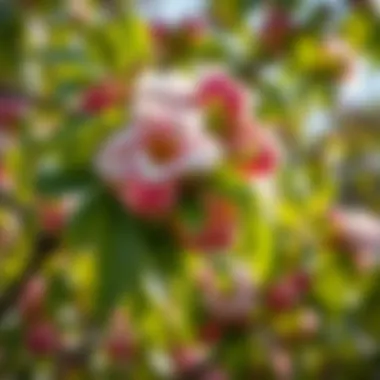

Types of Fertilizers
Fertilizers are fundamental for growth since they provide crucial nutrients that may be lacking in the soil. Here, we can categorize fertilizers into two main types: organic and synthetic. Organic fertilizers, like composted manure or fish emulsion, benefit the soil by enhancing its structure over time. They are slow-releasing and often contain a wide range of nutrients. On the other hand, synthetic fertilizers offer a quick nutrient boost directly to the plants. They can lead to rapid growth, but without the soil benefit that organic types provide. When deciding what to use, consider the long-term health of your soil and trees. Organic options tend to be favored for sustainable practices.
Application Timing
When it comes to application timing, knowing when to fertilize is vital. Generally, the growing season is the best time for fertilizing, especially in early spring as new growth begins. A cardinal rule is to avoid fertilizing during dormancy. If you feed the tree when it’s not active, you risk wasting nutrients and stressing the plant. Regularly check your tree for signs of growth to time your fertilization appropriately. It maximizes nutrient uptake and promotes healthy development.
Signs of Nutrient Deficiency
Recognizing signs of nutrient deficiency can make or break your fruit harvest. Common indicators include yellowing leaves or stunted growth, which can sometimes be mistaken for disease. Chlorosis, which is a yellowing of the leaves, often points to a nitrogen deficiency. If this occurs, applying a nitrogen-rich fertilizer will help restore vigor. Keep in mind that different nutrients affect various aspects of tree health, so being observant is key.
Pruning and Training
Importance of Pruning
Pruning is crucial for maintaining the shape and health of the peach tree. This process allows for better air circulation, reducing the risk of fungal infections and pests that thrive in dense foliage. It’s also a way to control growth and ensure that sunlight reaches all branches, facilitating fruit development. Regular pruning can encourage a more bountiful harvest, making it a practice that should not be overlooked.
Training Young Trees
When training young trees, it helps shape the tree's growth pattern right from the start. By training multiple scaffold branches, you can create a strong structure that can bear heavy loads of fruit in the future. This type of training should happen during the first few years to establish a solid foundation. Careful attention here can mean the difference between a towering mess and a well-organized, productive tree.
Seasonal Pruning Practices
Timing your pruning matters. Typically, late winter or early spring is ideal before new growth begins. During this period, you can assess dead branches without the foliage getting in the way. Seasonal pruning allows for fresh growth and the removal of non-productive branches. Although it may seem harsh, cutting back encourages rejuvenation and a healthier tree overall.
Pest and Disease Management
Common Pests and Diseases
Being aware of common pests and diseases is half of the battle in maintaining a healthy peach tree. Aphids, spider mites, and peach tree borers can cause significant harm if not addressed. Fungal diseases like brown rot can also threaten your harvest. The quicker you identify these threats, the better your response can be. A well-timed intervention can save your tree from serious damage.
Preventive Measures
Taking preventive measures is essential for a thriving peach tree. Introduce beneficial insects like ladybugs to keep harmful pests at bay, or install physical barriers to deter them from accessing your trees. Regularly inspect your tree for any signs of distress can help manage potential threats before they escalate. The goal is to create a balanced ecosystem that supports the life of the tree while minimizing pest impact.
Treatment Options
If pests or diseases do take hold, knowing your treatment options allows for swift action. Chemical treatments are available but should be used judiciously to prevent harming beneficial insects. Organic treatments, such as neem oil or insecticidal soap, provide a gentler alternative. That said, the approach will depend on the severity of the issue and the specific pest or disease affecting your tree.
"Proper and consistent care often transforms a small seedling into a magnificent peach tree, ultimately rewarding patience and diligence with lush fruit."
Understanding ongoing care and maintenance provides a comprehensive way to enhance the longevity and productivity of your peach trees. With dedicated effort in these areas, your journey from seed to harvest can lead to abundant, sweet peaches.
Harvesting Peaches
Harvesting peaches is a crucial phase in the process of cultivating these delightful fruits from seed. It not only signifies the culmination of careful planning and nurturing but also brings a sense of satisfaction to those who have invested time and energy into their peach tree journey. Getting this step right can ultimately influence the flavor, texture, and enjoyment of the peaches. The excitement of potential delicious treats makes it all worthwhile.
When to Harvest
Determining Ripeness
Determining the right moment to harvest peaches can be tricky for even the most seasoned gardener. A peach is ripe when it gives slightly under gentle pressure, has a sweet aroma, and boasts vibrant color. Missing the peak ripe stage might lead to loss of flavor and texture, making the peaches less enjoyable. Ripe peaches can be the crux of a delectable experience, elevating desserts, jams, and fresh eating.
Understanding the characteristics of ripeness helps homeowners maximize their harvest—this insight is paramount. But it's not just about picking them at the right time; it’s also about ensuring peaches reach their full potential in flavor. A peach that's too green can taste bitter, while one that's overripe can become mushy or ferment quickly.
Signs of an Approaching Harvest
There are clear signs that suggest your peaches are nearing the harvest stage. The color shifts as they ripen, often turning from a greenish hue to a rich gold or pink. As the peaches reach maturity, you'll also notice a softening of their skin, too. Observing these signs not just guides you through the harvesting process but also enhances the satisfaction of reaping what you've sown.
One unique feature to remember is that peaches often come together in bunches on the tree. Watching for the collective ripening of your crop can help you plan the best time to gather them all. However, be sure to check individual fruits, as they can ripen at varying rates.
Tips for Timing
Timing your harvest can be the difference between a mediocre peach and an absolute delight. While the aforementioned signs offer guidance, keeping track of the number of days since flowering can also help.
Typically, peaches will take about 90 to 140 days to ripen post-blooming. Additionally, think about the weather and the tree’s shading—peaches in direct sunlight often ripen quicker than those in shaded areas. It's a balancing act of monitoring the fruit and applying some good old common sense to get it just right.
Post-Harvest Care
Once the peaches are harvested, what you do next is vital. Proper post-harvest care can extend their shelf life and maintain quality, ensuring that you and your loved ones can enjoy the fruits of your labor for as long as possible.
Storing Peaches
Storing peaches correctly can greatly affect how long they last and how tasty they remain. Ideally, place them in a single layer in a breathable container away from direct sunlight. Refrigeration can cause peaches to lose their delicate flavor; instead, keep them at room temperature until they reach the desired ripeness.
A common problem arises when peaches are crammed too tightly together, as this can lead to bruising and rapid decay. So, a little bit of space can go a long way.
Preservation Techniques
For those looking to enjoy their peach bounty year-round, preservation techniques are worth exploring. Canning, freezing, or making jams can capture the essence of summer peaches for the colder months. Freezing peaches, for example, is as simple as blanching them in hot water and cooling them quickly in ice water before placing them in freezer-safe bags.
While these techniques require some effort, they provide the satisfaction of enjoying home-grown flavors in winter. They also help reduce waste, as any excess fruit can be utilized.
Utilizing Excess Harvest
If you're blessed with an abundance of peaches, utilizing the excess harvest can be a rewarding endeavor. Consider making everything from peach cobblers to smoothies for an instant taste of summer anytime.
Also, connect with your community by sharing some of your harvest. This can build relationships with neighbors while preventing waste. There’s a certain joy in knowing that your hard work not only feeds your family but also brings happiness to others.
Ultimately, harvesting peaches is not just about the fruit itself but encompasses the entire experience—from knowing when to pick, to how to store or preserve the yield. Embracing these aspects will not only enhance your journey but also ensure your peaches are as delectable as they can be.















